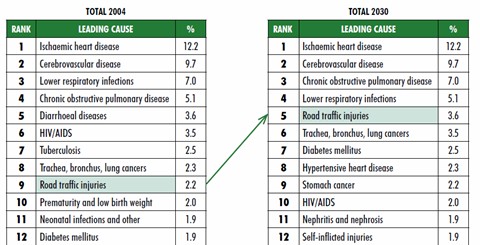
Yesterday, a pal of ours asked whether the following stat (gleaned from a recent Harpers article) could possibly be true: One out of every 85 humans living today will meet their end as a result of a vehicular accident. That figure may sound ridiculously astronomical, but data from the World Health Organization lends some powerful support to the factoid’s veracity. According to the WHO, 2.2 percent of 2004 deaths were attributable to “road traffic injuries.” (We’re not sure why there’s a discrepancy between that figure and the Harpers one, but we’ll just assume it’s a definitional issue.) As you can see above, the situation is projected to get many times worse over the next 20 years, as car ownership becomes more prevalent in China, India, Brazil, and elsewhere.
Even more surprising than the lethality of motor-vehicle traffic was this WHO tidbit on the people who suffer most from mankind’s need for speed:
Almost half of those who die in road traffic crashes are pedestrians, cyclists or users of motorized two-wheelers–collectively known as “vulnerable road users”–and this proportion is higher in the poorer economies of the world. For example, while in the high-income countries of the Americas Region 65 percent of reported road deaths are among vehicle occupants, this situation is very different in the low-income and middle-income countries of the Western Pacific Region where 70 percent of reported road deaths are among vulnerable road users. The report suggests that not enough is being done to meet the needs of these vulnerable groups. For instance, speed is a key risk factor for injury among pedestrians and cyclists, and yet only 29 percent of countries meet basic criteria for reducing speed in urban areas, while less than 10 percent of countries rate the enforcement of their speed limits as effective.
It makes sense that these countries would have problems with enforcement, as it requires oodles of money to pay for well-trained, well-equipped, non-corruptible police. So what’s left to turn the tide? As this WHO report makes clear, our best (and cheapest) option may be the humble speed bump, combined with center-of-the-road pedestrian havens. True, motorists hate speed bumps, but the cost-benefit here has to tilt in favor of the physical alteration that will save lives. Simply reducing average urban speed by seven miles per hour should be sufficient to prevent tens of thousands of deaths per year.
If the speed bump can, indeed, reverse the worrying trend of global road deaths, we can thank the town of Chatham, N.J., for its long-ago innovation. And at this point, Jersey could definitely use a public-relations counterweight to its increasingly disturbing image.


Ell // May 17, 2010 at 8:54 am
We’ve been working with the Wipe Off Five campaign for some years now – http://tinyurl.com/26ja62r
Brendan I. Koerner // May 17, 2010 at 4:10 pm
@Ell: Agreed, speed reduction in dense urban areas is by far the most effective means of reducing road fatalities. Unfortunately for the developing world, it’s also very expensive, since it requires consistent, honest enforcement. For nations without police forces able to provide that, I think speed bumps are the way to go.